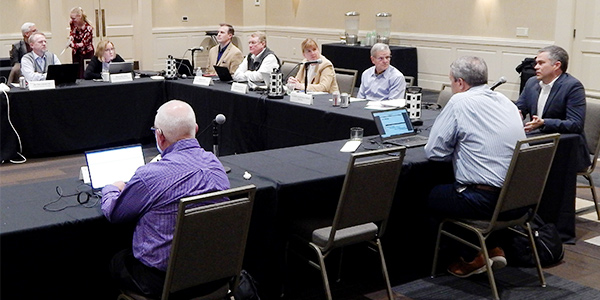By Tom Kleckner
SANTA FE, N.M. — SPP and its stakeholders have begun to grapple with the complex issue of how to use battery storage, but they must first determine who will guide the process moving forward.
Meeting Jan. 15, the Strategic Planning Committee heard from some members who wanted to create a task force and others who pushed for a steering committee.
Larry Altenbaumer, chair of both the Board of Directors and SPC, posited that SPP should take a strategic approach to the issue. He suggested the SPC again take up the subject at its April meeting in Little Rock, Ark.
“It sounds like a really good idea that we need to work out,” Altenbaumer said.
SPP Senior Vice President of Engineering Lanny Nickell agreed that the decision should be a strategic one. “What degree does SPP want to invest in the growth of batteries?” he asked. “Once we know that vision about storage, that will help guide what we know about batteries.”
“Someone has to take on a big-picture view of this thing, to get the discussion going and organize it,” Midwest Energy’s Bill Dowling said. “We have to do some of this up front in an organized fashion. We have to organize this herd of cats.”
SPP is working to get up to speed on FERC Rules to Boost Storage Role in Markets.)
FERC in October found that SPP’s first response “generally enable[s] electric storage resources to provide all services they are capable of providing.” However, it also required the RTO to adopt Tariff rules covering minimum run-time requirements for resource adequacy. (See FERC Partially OKs PJM, SPP Order 841 Filings.)
“Energy storage has the potential to change the way this industry operates,” said Richard Dillon, SPP’s market policy technical director. “Until now, energy had to be generated immediately. Energy storage changes that paradigm.
“But Order 841 removes barriers to ESR participation. That can be too much of a good thing. It responds so fast that the rest of the system can’t keep up with it,” he said.
Dillon presented a white paper on energy storage to the Markets and Operations Policy Committee at its Jan. 15 meeting. He returned that afternoon to discuss the paper with the SPC.
The paper lists energy storage’s benefits as its flexibility and ability to inject or receive energy; its instantaneous response to grid events; its ability to balance supply and demand; and its potential as an economic market resource and an economic alternative to traditional transmission.
It says SPP should capitalize on ESRs’ flexibility, maximize their reliability and economic benefits, develop cost-recovery for ESRs, and resolve issues on whether they’re used as generation and/or transmission assets.
“We have a great asset coming into our region and we don’t want to limit it,” Dillon said.
Dillon said ESRs’ decreasing costs — an 87% drop in real terms from 2010 to $156/kWh last year, according to Bloomberg New Energy Finance — and recent tax law changes have significantly increased requests to interconnect the resources to the grid. SPP’s generator interconnection queue contained less than 1 GW of ESRs in 2016. By mid-2019, ESR requests had expanded to nearly 7 GW.
The white paper makes several recommendations that touch six different working groups and SPP’s Market Monitoring Unit.
Southern Power’s Tim Hall suggested SPP take a page from ERCOT Technical Advisory Comm. Briefs: Sept. 25, 2019.)
Betsy Beck, with Enel Green Power NA, agreed with Hall. She said ERCOT felt things were moving too slowly and changed its approach.
“They put everything in. They’re moving really, really quickly to resolve these issues. It’s worked extremely well,” Beck said. “We need storage to come on and provide the maximum flexibility for ramping issues we’re seeing on the operational side.”






